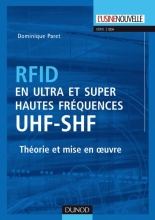Cet ouvrage offre une large synthèse à la fois théorique, technique et appliquée, des applications sans contact RFID en UHF et SHF. Afin d'aider à la compréhension de ce vaste sujet, cet ouvrage a été conçu en cinq grandes parties :
- principes physiques utilisés en RFID, fonctionnement du couple base station-tag, vocabulaire et définitions, marchés des applications sans contact et RFID ;

